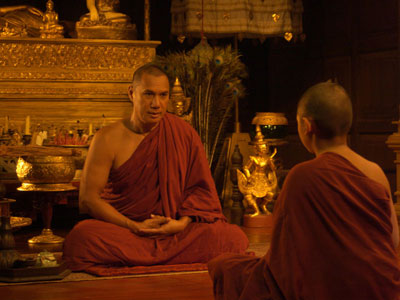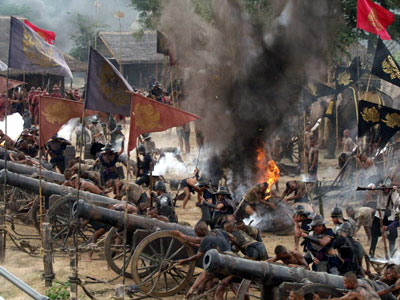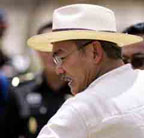|
As exotic and mysterious as Thailand may seem, its history has striking similarities to European history. Kingdoms rise and fall, dynasties bloom and wither, political intrigue is spurred by greed and the clash of cultures.
If a film about Thai history, for both knowledge and entertainment, tells us about the monarchy of Thailand from the past to the present, it must reveal that Thai kings in the past worked hard for their people.
King Naresuan, produced and directed by MC Chatrichalerm Yukol (known in the industry as Tan Mui) is just that type of film: an epic with elaborate production values, yet a film that firmly reveals the humanity and heart of historical kings.
They were leaders of vast armies and fought for their beloved countries, either for a new colony or to defend their own territory. Some Thai kings were slain in battle. Astonishingly, women also took part in wars and fought like men no matter what their class. The leader of a defeated kingdom was forced to send his son and daughter as hostages along with tribute such as troops, supplies, weapons, horses, and elephants to the victor.
Nearly 500 years ago, the great Ayothaya Empire arose in Thailand and the City of Pitsanulok was its barrier fortress.
In the year 1559, the neighboring and aggressive Burmese invaded the city of Pitsanulok. Phra Maha Thammaracha, the king of Pitsanulok, surrendered to the enormous military force from Burma because the Ayothaya Empire did not send reinforcements to aid in the war. Phra Naresuan, the young prince from the city of Pitsanulok and a son of Phra Mahathammaracha, was taken as a hostage when he was only nine years old and then was accepted to be a foster son of Bayinnaung the King of Burma.
Some years later, his older sister, Phasupankalaya, was sent to Burma, as well, as a concubine of King Bayinnaung. Later, Phra Naresuan was educated by a Buddhist monk called "Phramahaterakanchong" who was also a teacher of the King. He trained Phra Naresuan in the martial arts, literature, politics, and art of war.

It was common at that time that the defeated empire would send a princess to marry with the victorious king. It was an accepted tradition. But before the coming to Burma of Phrasupankalaya, the princess of Pitsanulok and older sister of Phra Naresuan, a secret strategy was put into play. A princess of the Ayothaya Empire and the second daughter of the Queen Suriyothai named "Phrathepkasattri" was unwillingly married with the King of the Lanchang empire in exchange for the reinforcements against Burma. Phra Mahathammaracha discovered the scheme of the Ayothaya Empire and told the King Bayinnaung to send troops to kidnap Phrathepkasattri. After Phrathepkasattri met the King Bayinnaung, she refused his offer and committed suicide instead.
For 15 years, all the people of the then-called Siam including Phra Naresuan lost their independence and were controlled by Burma. In 1584, three years after the King Bayinnaung died, the tributary relation of Siam with Burma was broken, which was inevitably followed by a vigorous attack by the Burmese army. Phra Naresuan emerged and fought back against the attack, and in 1586 he occupied Lanna, a buffer state between two kingdoms.

In 1590, King PhraMahathammaracha passed away, and Phra Naresuan officially became the leader of the Ayothaya Empire, King Naresuan. In 1591 the Burmese launched another attack to reclaim their lost territories. It was thwarted when the Burmese crown prince Minchit Sra was killed by Naresuan in a duel, a combat on elephants.
The following year Naresuan himself attacked Tenasserim (a city state of Burma at the time), as well as Cambodia in 1593. The Thais call him "The Great" because he extended (and united) Ayothaya (the capital of the Thai state) to include Lanna, Lanchang, Cambodia and some parts of Burma. He enforced strict discipline on his soldiers and the people. During his reign, Ayothaya was a very secure and powerful state.
To adapt Thai history and make it into a film for  Thai people and foreigners who want to know about Thai history, was not an easy task for Tan Mui. He spent a great deal of time in research in order to uncover the facts and truth of the historical events and to capture the look and feel of the times. It took nearly 7 years and 700 million baht ($20 million) to film this historical epic. Tan Mui said that he was proud that the film is a historical-based theatrical film and not a documentary. Thai people and foreigners who want to know about Thai history, was not an easy task for Tan Mui. He spent a great deal of time in research in order to uncover the facts and truth of the historical events and to capture the look and feel of the times. It took nearly 7 years and 700 million baht ($20 million) to film this historical epic. Tan Mui said that he was proud that the film is a historical-based theatrical film and not a documentary.
King Naresuan is an enjoyable experience for audiences. Reality and imagination are blended together nicely. Siam and Burma at that time were not so different in religious belief because both empires were Buddhist. Tan Mui created detailed spectacular scenes to clarify the confusion in history books. With this film, he tried to elevate the standard of Thai movies to a higher level. Tan Mui also illustrated the brilliant strategies that Naresuan used to fight the Burmese empire many times after Siam declared its freedom. Although Naresuan did not have enough soldiers to fight against the superior Burmese forces, in the end he and his army managed to achieve victory. Like the challenge to the filmmaker, it was not an easy task to be a good and at the same time successful king.
For more information please visit:
www.kingnaresuanmovie.com/index_eng.php
|
